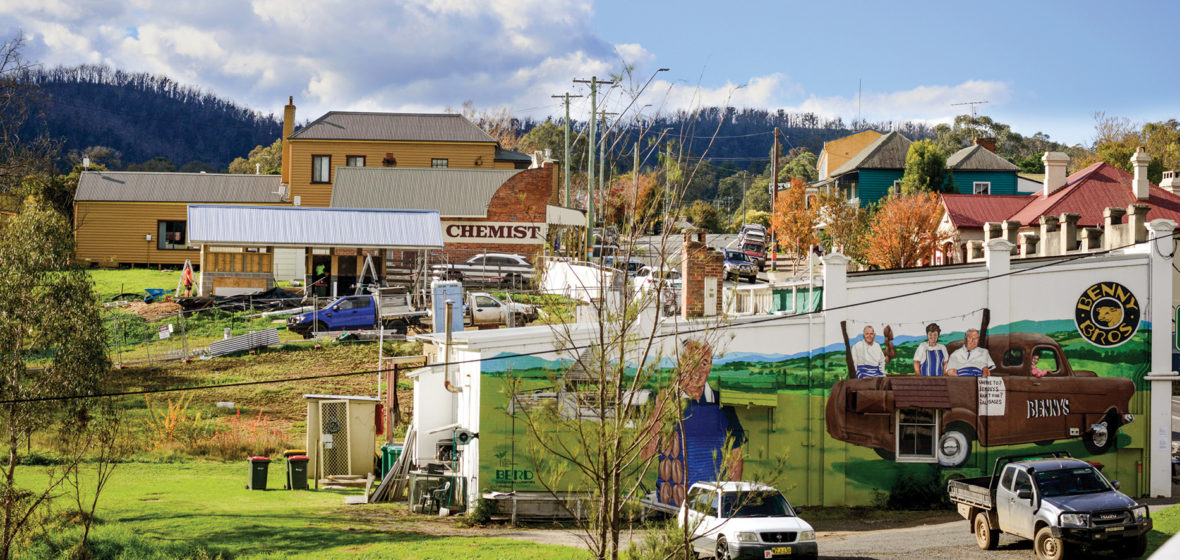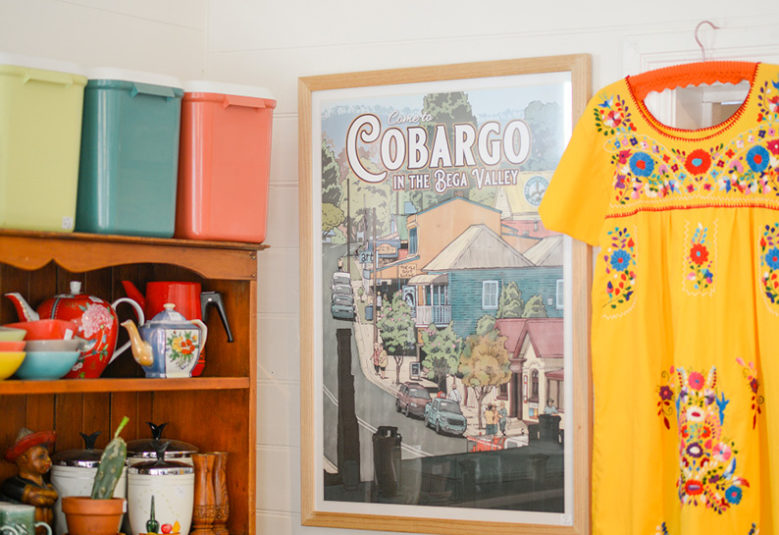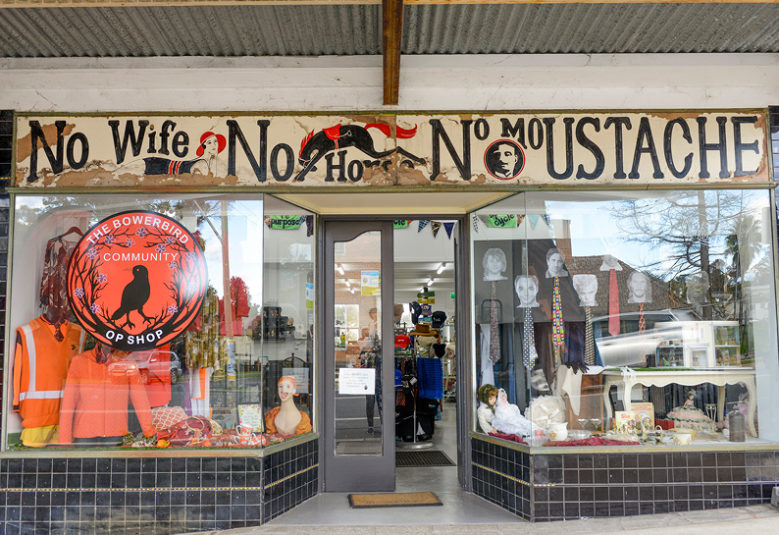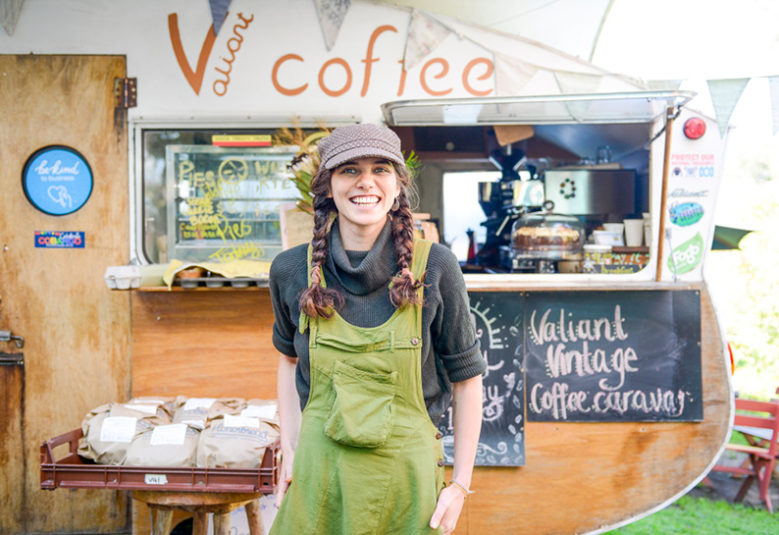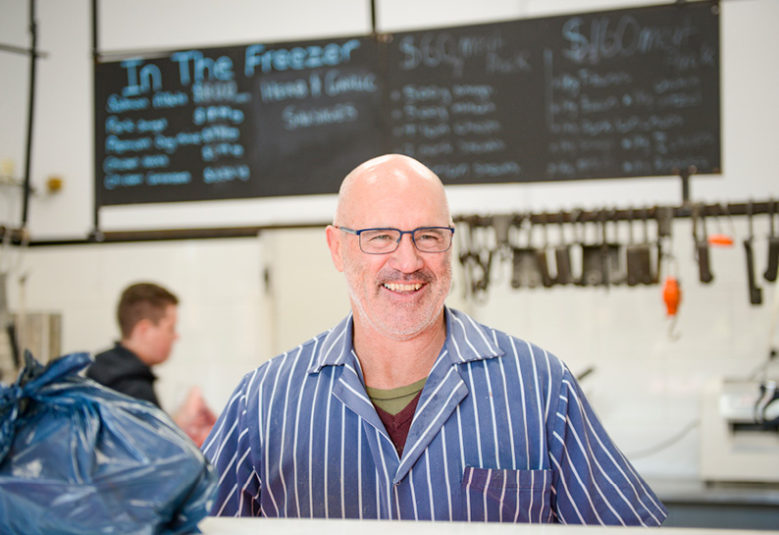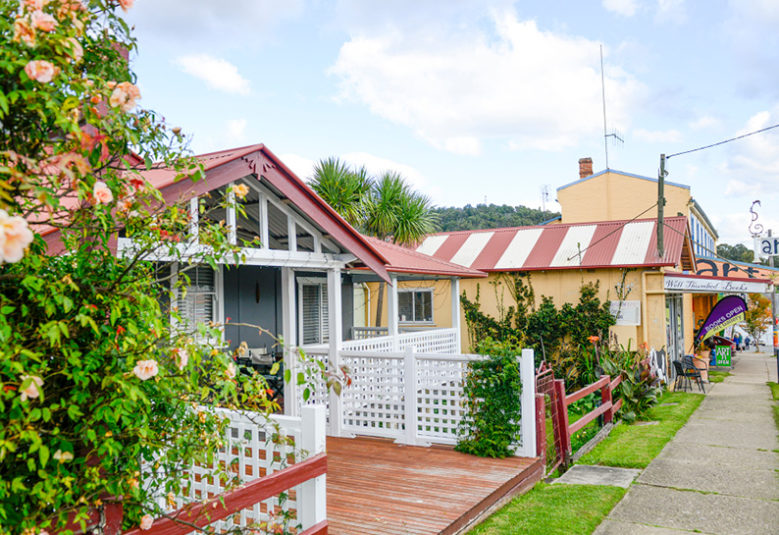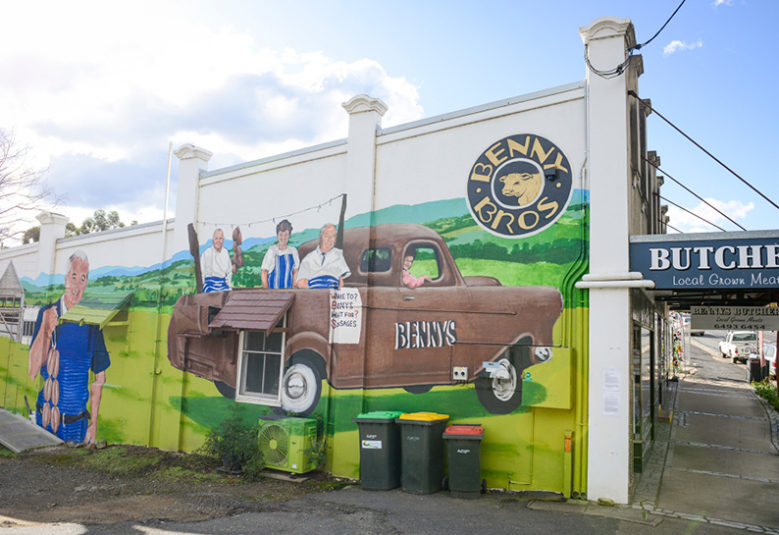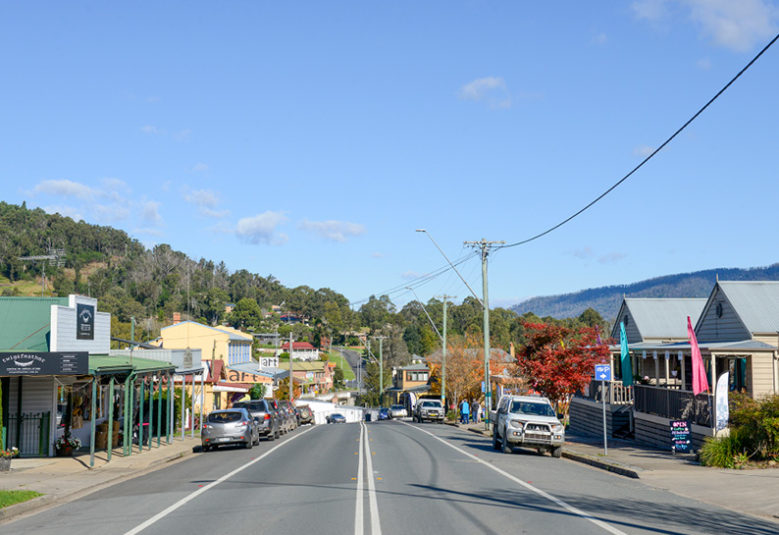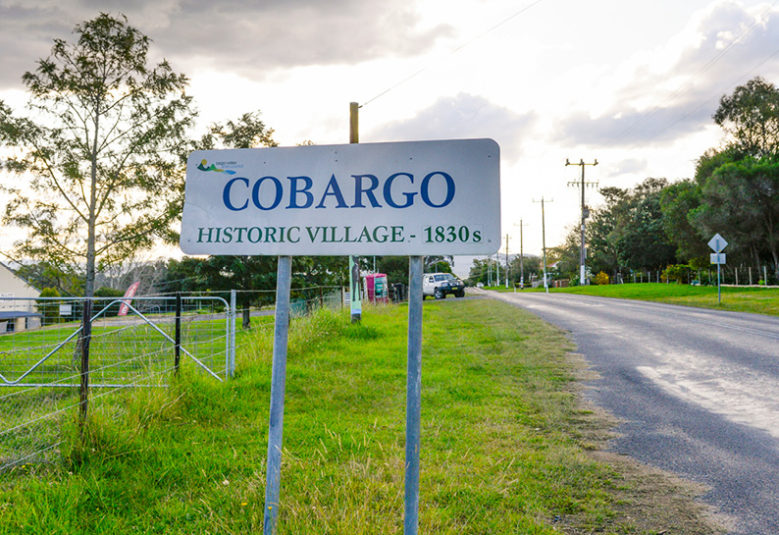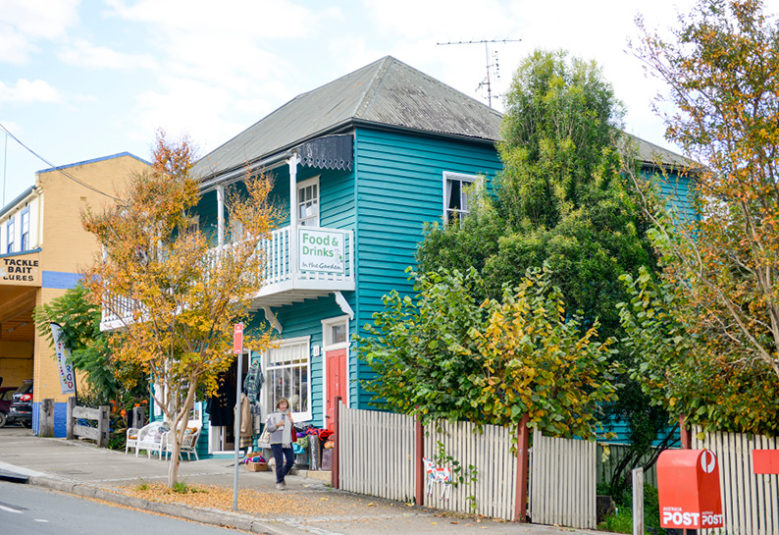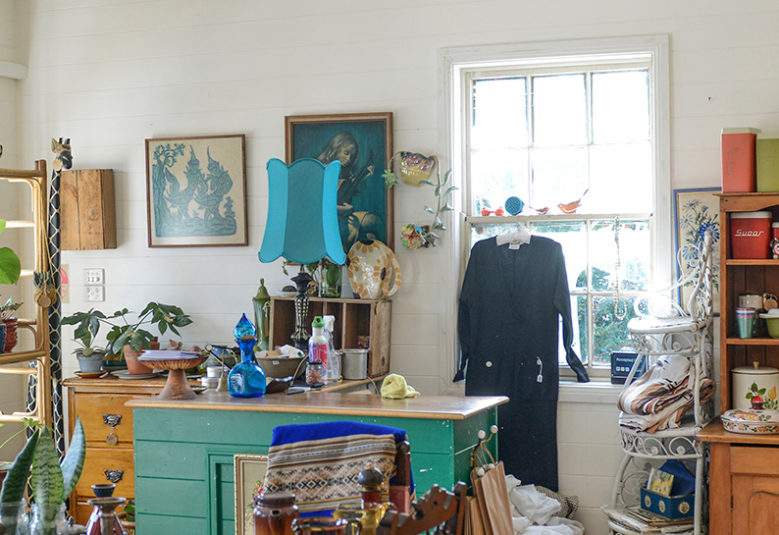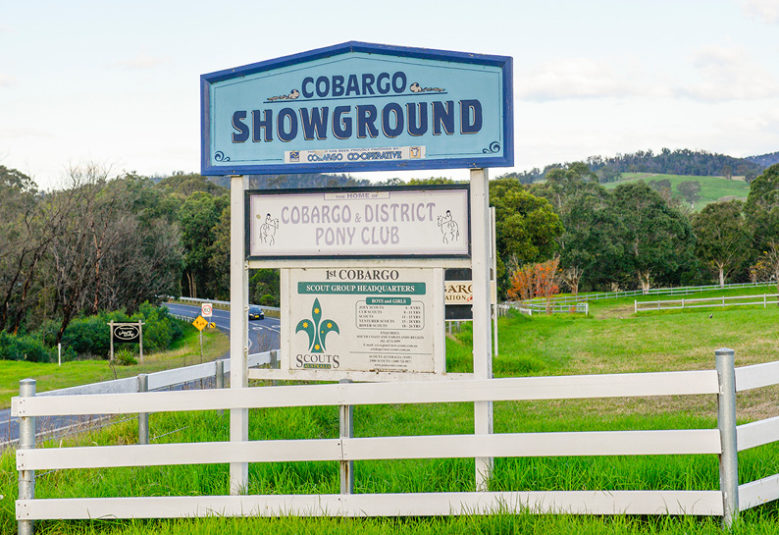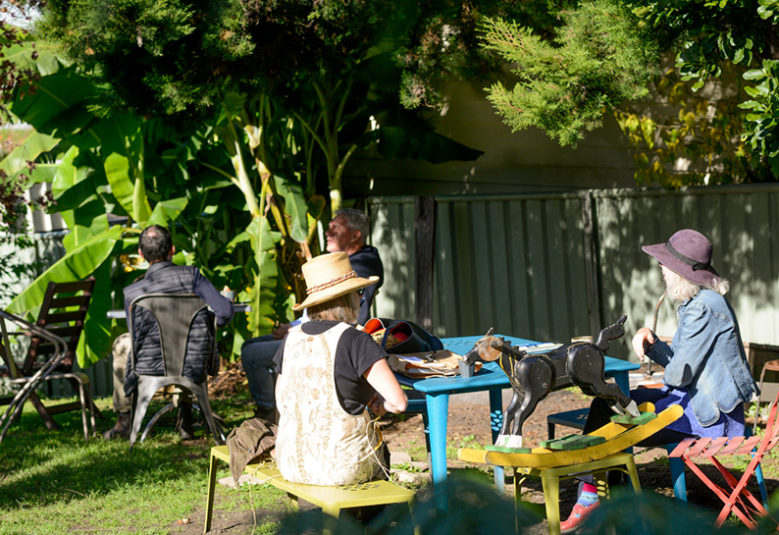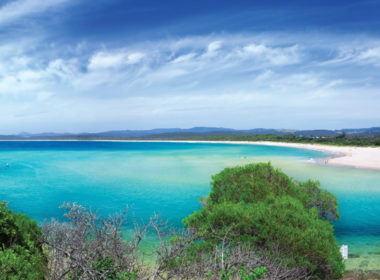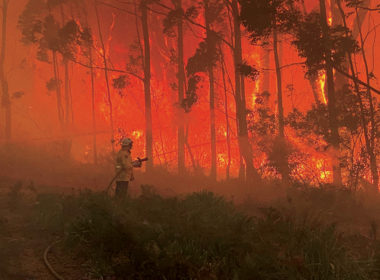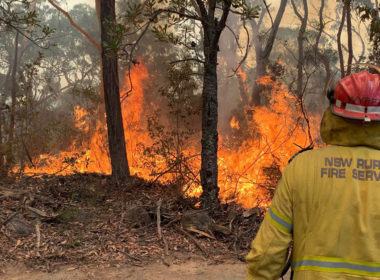REGIONAL REPORT: COBARGO AND THE FAR SOUTH COAST
More than two-and-a-half years on from the Black Summer bushfires, rebuilding physically and psychologically is still in the early stages for many communities on the NSW South Coast - and solicitors are playing a key role. The small town of Cobargo became the defining symbol of a country in crisis. Its people feel forgotten by cascading disasters since that summer but are working hard to heal and learn from the tragedy.
Theirs is a story of the resilience of the human spirit.
In the pre-dawn hours of New Year’s Eve 2019, Cobargo was burning and publican David Allen’s mobile phone was ringing. The catastrophic fires across South Eastern Australia that summer had reached the historic dairy family village in the form of the Badja Road Forest Fire.
The way Allen describes the initial hours after the “beast rolled into town” is not dissimilar to a warzone. Embers raining from a red sky, thick smoke clogging airways, silence once filled by the familiar call of wildlife, a sense of terror.
Within a few hours, hundreds of homes in the area were decimated, thousands of farm animals were lost, eight buildings in Cobargo’s quaint main street were flattened, and five people lost their lives. The scene was a far cry from the picturesque blend of rolling grazing lands and forested ranges that Allen has called home since he was a boy. Piecing together dozens of witness accounts from that day in Cobargo reveals a pastiche of mayhem. Every person has a different story about what happened when their town went up in flames and the emotional churn from the events that followed.
Amid the chaos, Allen distinctly remembers his phone lighting up “all day and night”. Not that he could visibly tell what day it was, nor how long he had been standing outside the Cobargo Hotel wielding a hose as flames danced metres from his face. The blaze melted the pub’s phone lines, diverting all calls to Allen’s personal device. He was inundated with desperate pleas for information from distraught locals about the status of their families and properties. Persistent interview requests from journalists and donation offers from far corners of Australia followed.
“We sort of became a de facto call centre; rightly or wrongly. People checking up, wanting to make donations, ringing to see how things are … the whole gamut: good and bad,” Allen says, tears pricking in the corners of his eyes as he recalls the conversations.
On the other side of town, local Ange Kane’s phone was also ringing. She quashed the dread for her extended family also battling fires further south on the NSW-Victorian border and opened her home to the community of Cobargo; people she had called friends for 20 years. “My house ended up full of people. They didn’t know if their family was dead or alive. One of my friends left her son and her husband out at the farm. She came into my place at 4am or 5am,” Kane says.
“At one stage after the fires, I was getting over 100 calls and messages a day. It never stopped. You take on that role as a community leader. Because you put yourself in that position and people are so vulnerable, they attach themselves to it. You live and die by those calls and you are prepared to. That is what makes us who we are.”
Cobargo, like many rural communities on the NSW South Coast, rallied to its own defence in the aftermath of the blaze. Long before official help arrived, locals took on the responsibility of feeding and housing people, delivering fodder to at-risk farm animals, and organising a constant stream of donated goods.
Volunteerism is indelibly marked in Australia’s DNA. Cobargo, like many rural communities on the NSW South Coast, rallied to its own defence in the aftermath of the blaze. Long before official help arrived, locals took on the responsibility of feeding and housing people, delivering fodder to at-risk farm animals, and organising a constant stream of donated goods.
“We were all in a life raft, not a cruise ship. Every person I asked to help said yes. It was totally a community effort,” Kane says. But as the world became fixated on the COVID-19 pandemic just three months after the bushfires, emergency services and media swiftly moved on, leaving victims to grapple with the fallout of the disaster. What happened that summer continues to define the lives of people in Cobargo, revealing the long-lasting toll these catastrophes have on individuals, families and communities.
‘The day she stole the sun’
Driving down the Princes Highway from Sydney to the NSW South Coast, you would be forgiven for being unaware a disaster had swept through there. At the time of writing, NSW has received an unprecedented amount of rain in recent months. The sprawling countryside is coloured by luscious green fields for kilometres. The trees lining each side of the highway brim with new growth, but their scorched trunks carry the memory of Black Summer.
Billboards scrawled with ‘How fireproof is your plan?’ appear more frequently past Nowra, as do advertisements for Rural Fire Service volunteers.
The 2019-20 bushfire season was the most devastating in NSW history. Several years of drought combined with higher-than-average temperatures and low humidity provided optimal conditions for fires to spread. Over the course of the season starting in late August 2019, 26 lives were lost, 2,448 homes destroyed, and 5.5 million hectares of land burnt. That is the equivalent of twice the size of Belgium. It’s estimated more than one billion animals in NSW alone perished in the fires. The impact on communities, farmers, local businesses, wildlife and bushland is unparalleled in the state’s history.
Cobargo lies between the coastal town of Bermagui and the Monaro high plains, on the lands of the traditional custodians, the Yuin nation. The town traces its European history back to the 1820s when settlers first moved stock into the local area.
Situated in the electorate of Eden-Monaro, a famous swing seat, Cobargo hosts a “diverse group” of about 800 people. Once a conservative population of farmers, it has become increasingly attractive to retirees from Canberra and what are commonly described as “creative types” from far-flung corners of NSW and Victoria. The local fishing, forestry and farming industries are all in decline, and the district has largely become a tourist stopover point for the South Coast. This shift is visibly reflected by the businesses that occupy the main street. “When I was a kid growing up in Cobargo, the main street was very traditional with two butchers and a general store. That’s changed now into tourism, boutiques, secondhand clothes, cafes. It’s not unique, a lot of towns have gone through that,” Allen says.
Allen is no stranger to fires. Although he never joined the local brigade, growing up he fought grass fires on the family farm more times than he can count. Like many others in town that summer, he was monitoring the media and checking fire warnings for imposing threats. “We knew it was coming. The creek bed at the front of the pub was dry. We had been watering around the pub, making sure the laws were green. It was totally different to what it is now where we’ve had one of the wettest summers ever and it hasn’t stopped raining. Three years ago, it wouldn’t rain,” Allen says. Although the town was alert to the possibility of a bushfire, a common thread that connects people’s stories is that it “came out of nowhere”.
Melissa and David Britton, long-time residents of Cobargo and self-confessed “rev-heads”, set off for the annual Summernats car festival in the early hours of New Years Eve 2019. They left their property just outside town as they do every year; the cat and dog fed, the yard clean and grass mowed. Their six vintage Holden cars sitting neatly in the paddock – the last time they would see them intact. Melissa vividly remembers checking the ‘Fires Near Me’ application on her phone before their journey and recalls seeing a fire 47 kilometres away. “A week and a half before the fires, we were getting black leaves dropping out of the sky. But we didn’t think it would ever get to Cobargo,” she says.
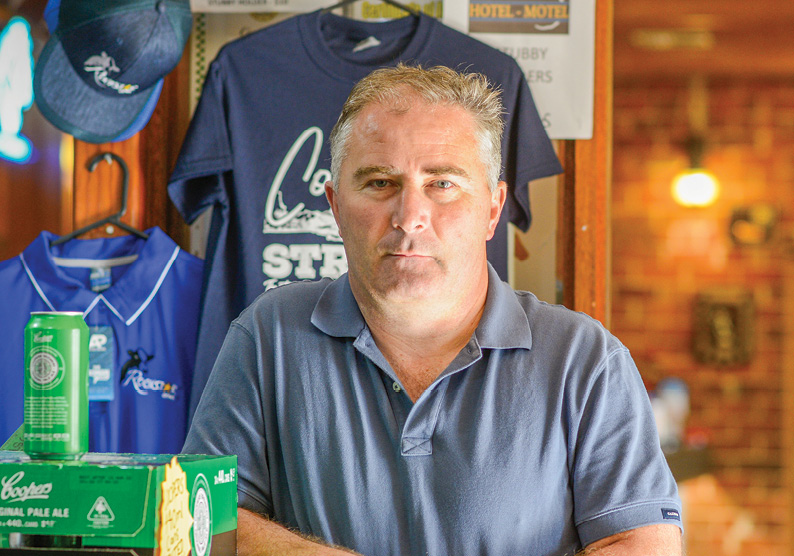
Forty-five minutes out of town, the couple got a call telling them Cobargo was on fire. “We tried to come straight back, but we got just out of town and the whole car was covered in flames. There was fire both sides of the road. We couldn’t come any further,” Melissa says.
Locals didn’t know the blaze by its official name then, only that a “monster” rolled into town and started destroying homes and lives. Almost three years on, there is a reluctance to mutter the words ‘Badja Road Forest Fire’. The fire was ignited by a lightning strike four days earlier in a logging dump in the high country near Cooma, 400 kilometres south west of Sydney. The fire moved rapidly in the first 24 hours, fuelled by the strength of a westerly wind, towards the small communities of Cobargo, Bodalla, Quaama and Coolagolite in the Bega Valley. The fire front peaked at 15 kilometres wide across the flanks, joining with other fires as it roared towards the coast. Late in the evening on 30 December, the blaze “sprinted” 35 kilometres downhill over the course of a single night, reaching Cobargo at 4am. Experts giving evidence to the NSW Bushfire Coronial Inquiry in September 2021 described this spread as “extreme and unprecedented”.
Builder Mick Thomson, who lives on a property four kilometres from the centre of Cobargo, had been up all night looking for spot fires and making sure his firefighting gear was prepared. Thomson moved into the property only three weeks before, unloading the last of his belongings in the days before the fire.
When the Law Society Journal speaks to Thomson, he shows two videos to demonstrate how fast the fire advanced that morning. The first, timestamped at 7:57am on 31 December 2019, displays a slightly overcast sky, a thin film of smoke and what he says looks like “someone burning off” in the paddocks. Thomson swipes left to reveal the next video, taken less than an hour later at 8:43am, telling a different story entirely. Red and yellow flames engulfing his home under a black sky, the scrape of collapsing metal, embers hitting the steel and the fierce whir of the wind. Thomson’s voice chokes several times while recounting his story, still visibly distraught by the near-death experience.
“The fire came three different ways all at once. Next thing I knew, it was like a holocaust. We thought we had missed it, but it came up the hill with the wind behind it. The fire was up over my head and I could feel it hit me.”
“I thought we could save the house; we had a firefighting pump, hose, and a 1,500-litre tank.
“We were inside the garages, but the fire came and caught everything on fire. My partner at the time was sucking up air off the concrete … I knew we had to get out of there. I carried my partner over the cars and out through the roller door. We couldn’t see anything at that stage because it was so thick with smoke. I couldn’t get to the dogs … We got in the 4WD buggy and drove 50 metres through the flames to the highway.”
The Badja Road Forest Fire was the deadliest blaze of Black Summer, with a further two people dying as the fire raged on for 10 weeks. A staggering 315,000 hectares of land burned, destroying more than 400 homes. “It is quite extraordinary given the ferocity, spread, and duration of this fire that the death toll was not higher,” said Adam Casselden SC in the opening address of the NSW Bushfires Coronial Inquiry.
After the fires, the NSW Rural Fire Service commissioned the Bushfire and Natural Hazards Cooperative Research Centre to undertake an investigation into community attitudes and experiences of the 2019-20 bushfire season. One study looked at the challenges around community expectations of bushfire warnings and found many people expect to receive “highly detailed and localised information in near real-time” in order to make better decisions about their safety. More than 200 in-depth interviews were conducted with people affected by fires across NSW, and more than 1,000 others completed an online survey.
The legal issues stemming from disasters of this magnitude are complex and varied. For many, the aftermath of the bushfires represented the first time in their lives they needed legal help. For others, the legal issues arising from the tragedy added to, or compounded, existing problems.
“We rang triple zero and they told us to stay because it was too late to go. We didn’t have a choice. If we had better information and it was more accurate, we could have just left at any time,” Thomson says. “We only found out days later that Cobargo burned at four in the morning. We could have driven down the road before it even hit us.”
The “extremely unusual” and “super abnormal” movements of the Badja Road Forest Fire were unpacked during the Coronial Inquiry. The officer in charge of the investigation into the fire, Detective Senior Constable Glenn Bradley, told the inquiry that bushfires do not typically spread uninterrupted downhill through the night. “In all your years as a fire investigator, have you ever heard of anything so remarkable?” Council assisting Adam Casselden asked Detective Bradley.
He responded: “Not even close”.
The aftermath
Solicitors played a critical role in support and recovery in the wake of the bushfire tragedy in NSW. The legal issues stemming from disasters of this magnitude are complex and varied. For many, the aftermath of the bushfires represented the first time in their lives they needed legal help. For others, the legal issues arising from the tragedy added to, or compounded, existing problems.
There was an overwhelming response from the legal profession to the bushfire emergency, with the Law Society of NSW and NSW Bar Association receiving hundreds of offers of pro bono assistance. Insurance was the most common legal issue, comprising half of all services provided by Legal Aid NSW’s Disaster Response Legal Service (DLRS). The Insurance Council of Australia advised insurance claims from the bushfires in 2019-20 across NSW, QLD, Victoria and South Australia numbered more than 38,000 with estimated losses of $2.32 billion. NSW accounted for 81 per cent of these losses, or $1.88 billion.
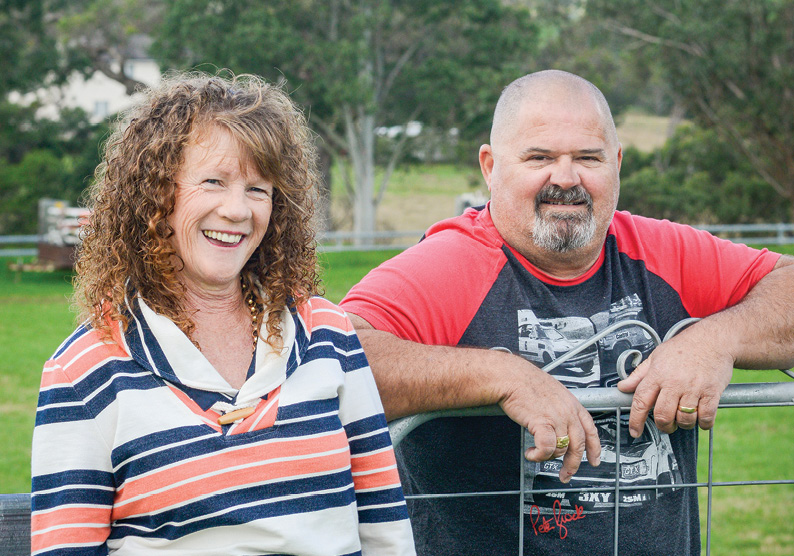
Manager of the DLRS Sally Bryant says one of the biggest challenges in the aftermath was locals feeling disempowered and disconnected. Many people didn’t have reception for months, preventing them from lodging claims or finding out where they were up to. “People that would otherwise be capable of dealing with these issues, when they are thrown at them all at once, and they are facing homelessness in a moment, they just need help and support,” Bryant says.
From January, solicitors were deployed to the communities most seriously impacted by the fires, attending recovery centres across the South Coast including Batemans Bay, Bega and Ulladulla. These centres offered a “one stop shop” for people, providing access to government services like housing and health, charities including the Red Cross and St Vincent de Paul Society, insurance providers and legal assistance.
The DLRS provided more than 740 legal services to affected people on the South Coast to the end of June 2020, the majority of these at recovery centres. To date, they have provided 1,405 services to bushfire victims, including advice and referrals. Justine O’Reilly, Principal Solicitor at Shoalcoast Community Legal Centre, says in the immediate aftermath of the disaster, victims commonly gravitated towards charities or their insurers, but solicitors were a necessary presence in the room. Shoalcoast CLC covers much of the NSW South Coast and the Snowy Monaro and worked closely with Legal Aid to support the communities. “We really wanted to be in those disaster recovery centres to be able to help however we could. We weren’t the first port of call, but we were there. Initially, people were shell shocked, so the legal issues didn’t play out until later. But we were able to make a difference in people’s lives,” O’Reilly says.
Solicitors also attended “mobile recovery centres” in more remote communities like Cobargo, where residents established a makeshift relief centre at the town’s showground. A small group of locals, including David Allen, Ange Kane and the Brittons, joined forces to pull available resources before official services arrived. “We had to fend for ourselves, so we got organised. People were pitching in everywhere. We got power from generators, a cool room running and a kitchen operational. I don’t think I had a shower for five days,” Allen says.
The DLRS provided more than 740 legal services to affected people on the South Coast to the end of June 2020, the majority of these at recovery centres. To date, they have provided 1,405 services to bushfire victims, including advice and referrals.
“The good people did great things. I took on that role because I knew I could help. At one point we got 1,300 bales of hay to the showground and I knew we were going to be okay. The biggest thing I tell people is that a farmer will feed his animals before he feeds himself,” Kane says.
“I don’t need recognition for what I did. I did it for my community. The people that I helped all thanked me and that is enough for me. They bought me a beer,” David Britton adds.
The Cobargo Showground was the site of one of the most politically charged moments of that summer. A few days after the town was decimated, then Prime Minister Scott Morrison toured the makeshift relief centre. It was a chance for him to shake hands and speak with victims; an attempt to undo some of the public relations damage caused by him holidaying in Hawaii during the fires.
In the smoky ruins of a town most people had never heard of, a woman wearing a Led Zeppelin t-shirt and walking a goat on a leash, stood out amongst the crowd of locals as she confronted Morrison. “How about some money for our forgotten corner of NSW, Mr Prime Minister?” The exchange was captured by media, and subsequently went viral. It was picked up by international news outlets and became a metaphor for a broader wave of frustration towards the Federal Government and the handling of the bushfire crisis, including the slow rollout of assistance.
However, the spotlight wasn’t collectively welcomed. “It just wasn’t a reflection of what was happening … There were so many other good stories and things happening. People were hurting, people needed help and the focus was put on that incident,” Allen says.
“My belief was the government could have said, ‘what do you need?’ and we could have said, ‘this is the list of everything urgent’. But that never happened, because Morrison got in his car and left. That was the turning point where it really hurt the people of Cobargo,” Kane adds.
Once government assistance, charities, insurers and emergency services took up residence at the showground, the dynamic in Cobargo shifted. What emerged tells a story of a weary community, reeling in the aftermath of a disaster, forced to battle the “mind-numbing bureaucracy” of filling out forms, talking to services and constantly “justifying their trauma”. The reliance on external help and donated goods, in some cases, solidified into jealousy, suspicion and guilt. It is common to be told that someone received more than their fair share.
When the Law Society Journal visits, the overwhelming mood of the community is one of resilience; desperately trying to heal from the horrors. David Allen and Ange Kane point to the well-intentioned but convoluted nature of having access to a plethora of services and are now calling for a more streamlined response to disaster management and recovery.
“The unsolicited donations, the bureaucracy, the slowness of getting the money out the door … There are so many different organisations and charities. They are all trying to do the right thing. But because there was no coordination there was overlap, there was waste, there were people getting missed. It was messy. We should learn from it. It’s never going to be perfect, but it should be better,” Allen says. “Having someone or something tie together the charities, services and different levels of government to make it easier for people. Then once people are in the system, their circumstances and what they need can be matched up with what they are eligible for.”
President of the Shoalhaven and District Law Society at the time of the fires, elected local councillor, and property lawyer Paul Ell says this issue informed many of the conversations he had with clients and is one of the biggest lessons from the disaster. “People had to constantly provide the same information. There was a sense that the left hand didn’t know what the right hand was doing at times. When people are in the midst of such a traumatic experience, the last think they want to do is have to constantly fill in forms and justify their position. That is something people found exhausting,” Ell says.

Competitive grant funding is not how you do recovery in a disaster site… I know whole communities fell apart in the grant writing stage, because they didn’t have the capacity. How do you when you are decimated?
The ongoing cycle of trauma
Bushfire recovery is a deeply complex and grueling process. Emergency services were there at the beginning but swiftly moved on when the COVID-19 pandemic took hold in Australia in March 2020. DLRS Manager Bryant says recovery centres were forced to close and services started retreating when healing and rebuilding had barely begun. While solicitors could not physically be on the ground anymore, the DLRS ran a trauma-informed helpline for victims. “Everybody felt very much like it was a job not quite finished and we would have liked to have been there to see people through their recovery journey. But it was fantastic to be able to support through the telephone service,” Bryant says.
The painfully slow pace of recovery, both physically and psychologically, is at the heart of much of the frustration felt in Cobargo. The eyes of the world were on the small town at the time, but the community feels forgotten by the cascading disasters since then.
Two-and-a-half years on, many people who lost their homes in the disaster are still in the early stages of rebuilding. The pandemic halted the supply of builders and resources, meaning in 2022 some victims are still living in caravans, tents and shipping containers initially brought in as “temporary measures”.
Mick Thomson, who lost everything on his 60-acre property, still hasn’t moved into his newly built house and has encountered relentless issues with everything from obtaining his full insurance payment to locking in a time to lay the slab bed. “I’m a builder by trade. By six months after the fires, I thought we would be back into it and starting the rebuild, but that hasn’t happened,” he says. “Hopefully by the end of this year I will be in the new house.”
Ell explains that even once victims received their insurance payout and battled council restrictions, the rising cost of living and materials exacerbated financial hardship and added an extra level of stress to an already traumatic situation. “Housing is still a big issue for people on the coast. They are under-insured and if they want to build now it is so much more than they were covered for. That is an ongoing trauma and challenge people are facing. The goal posts have shifted on them in a way they couldn’t be ready for,” he says.
Legal issues for individuals and families are now more complex. Given the time frame, outstanding insurance issues may have already been through external dispute resolution and are now pending litigation. Questions around government grant funding and reviewing decisions have also become common, adding another hurdle to the wider recovery effort.
In Shoalcoast Community Legal Centre’s submission to the Senate Inquiry about the lessons learned in relation to the Australian bushfire season 2019-20, they highlighted that temporary accommodation clauses in insurance contracts were insufficient. They outlined the “vast majority of contracts” limit the insurer’s liability to pay for temporary accommodation to a period of 12 months. “After the 2019-2020 fires, the scale of the cleanup was unprecedented. Many of the clients referred to SCLC for advice did not have their blocks cleared until June or July 2020. Only at this stage were they able to hire surveyors, planners and architects to begin the design of their new home. For those persons, the estimated time for completion of their new home was October 2021, that is 20 months after the bushfires,” the submission read.
Bryant says the DLRS worked with insurers to extend temporary accommodation, in many cases, for an additional 12 months to alleviate the ongoing cycle of trauma and financial hardship for many victims. “We started to see a surge in clients again around the anniversary of the fires. The temporary accommodation was running out, but nobody was in a position to rebuild … People were really traumatised around that period asking what they were going to do, and where they were going to go.”
Legal issues for individuals and families are now more complex. Given the time frame, outstanding insurance issues may have already been through external dispute resolution and are now pending litigation. Questions around government grant funding and reviewing decisions have also become common, adding another hurdle to the wider recovery effort.
Community-led recovery
Recovery after a natural disaster largely depends on the capacity and energy of the community. In the wake of the Cobargo fire, recovery groups and committees began to take shape. Local people, still traumatised, gathered on many occasions to discuss the future of their town and what they needed to heal. The most important topic on the agenda was rebuilding parts of the main street destroyed in the fire. The loss of eight historic commercial buildings in the lower half of the village precinct not only saw the loss of many loved businesses that formed a part of the rich tapestry of the town, but also left a physical gaping hole in the village’s commercial centre. For many, it is a daily reminder of the devastation the people of Cobargo endured, and the ongoing pain felt in the community.
After the damage, it was clear Cobargo’s main street no longer provided the essential services to sustain the economic and social wellbeing of the community. Rhonda Ayliffe’s family has been in Cobargo for generations, and one of the buildings lost in the blaze was part of her heritage for almost 80 years. Her parents, Brian and Mary, donated the land to the community in the days after the blaze to lift spirits and hopefully begin the long recovery journey. “People were unsure along the main street about what to do next. My parents announced it to the town as a way to anchor things. Once you start something like that, it gathers momentum and it creates hope,” Ayliffe says.
Ayliffe is now the Vice-Chair of the Cobargo Bushfire Resilience Centre (CBRC), a group formed in the weeks after the firestorm wiped out the town and the area was still in a state of emergency. The CBRC is one of several not-for-profit organisations working on large-scale projects to rebuild sections of the main street and secured funding through the Bushfire Local Economic Recovery package (BLER), co-funded by the Federal and NSW State Governments.
The CBRC has a vision for a community culture centre; a space for exhibition, performance and commemoration. Once built, the centre will echo some of the spaces and sizes of the buildings that were lost and include a memorial courtyard.
Ayliffe explains rebuilding on a site that carries so much loss and devastation requires extensive community consultation. She says the divisions that may have emerged after the fires when the town was broken, need to be put aside for the greater good of the community’s recovery.
“Every single stage; from the flames, to the rubble, to when trucks turned up to take it all away. Each stage is a new trauma for the community. It’s a newness of the street, made fresh each time. Even when each of us are building something there, every single day it will be difficult for our community. We know how hard it will be no matter what you put there, no matter what it looks like. We have to be very mindful of how we go forward with that,” Ayliffe says. “When you’re talking about community, that means everyone. A diverse voice of people needs to be respected in that process. You can’t please everyone, but you do need to listen deeply and try to respect that difference of opinion. You have to go forward together, and difference doesn’t have to mean division.”
In addition to the difficulties and delays with rebuilding was the process of crafting a submission to the Government’s BLER fund. Stage two of the package focused on recovery and resilience projects, driven by the specific needs of each community. More than 650 project applications were received from 47 local government areas impacted by the bushfires in NSW, requesting a total of more than $1.6 billion – more than six times the original available funding.
Ayliffe says the process was onerous, complex and highly competitive. Applications were open from October 2020 to January 2021 and the CBRC, like many other community groups, were working “around the clock” to hit the deadline, enlisting the help of solicitors and business experts. “What have we learnt? That competitive grant funding is not how you do recovery in a disaster site … I know whole communities fell apart in the grant writing stage, because they didn’t have the capacity. How do you when you are decimated?” “We needed to fight for a limited pool, so everybody scrambled over everybody else. Like someone drowning in an ocean, and the person who has gone out to save them pulls them under even further. The process itself was very damaging to communities.”
Australian Business Volunteers CEO Liz Mackinlay saw the “infamous exchange” involving Scott Morrison at the Cobargo Showground on television. She thought that once the politicians and media left town, the community would need support rebuilding. Fast forward to September 2020, Mackinlay and her ABV staff drove to Cobargo to meet with community organisations, including the CBRC. ABV is a not-for-profit, made up of several hundred skilled business professionals, who work with communities across Australia and Asia-Pacific in times of need and disaster.
“I said to the community: ‘you are the head and the heart of this, we can be your arms and legs. We can bring people alongside you, help you with grant submissions and business plans. You are in charge; we are here to support’,” Mackinlay says. “A competitive grant round does not build community. The whole point of all this money is to rebuild stronger, more resilient communities. “The grant round came out, everyone had to go to their corner and hunker down. There is no bad blood. But as an outsider looking at an integrated community, looking at resilience, looking at how things build back better, the government having competitive grant rounds is anathema to all those words around strong, resilient, inclusive communities.”
The CBRC secured $4.8 million from the BLER fund for their project, but Rhonda Ayliffe foresees more hurdles appearing due to the rising cost of living. She fears the project will no longer meet budget, causing further delays with the rebuild and creating more time Cobargo’s people will need to live with the physical reminder of Black Summer.
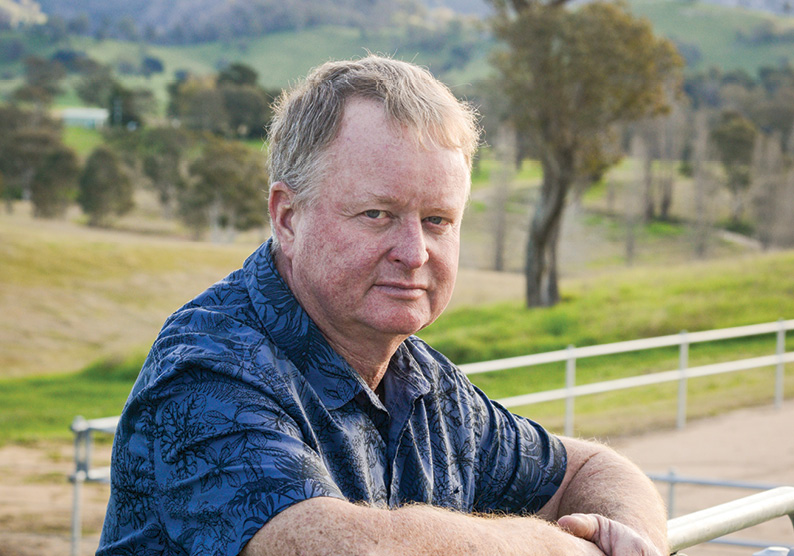
A new battleground
The emotional toll of the bushfires still bubbles under the surface of most conversations with people on the NSW South Coast and Cobargo. Family lawyers are now seeing the cumulative trauma and hardship play out. Treasurer of the Far South Coast and Monaro Law Society Kirsty Salvestro says families fell apart after the bushfires, and sadly she “sees the end” of the problems that surface as a result of being in a “constant state of stress”. “I’ve seen a lot of people struggle. They’ve had this ongoing mental health issue that caused people to change. People change when they suffer through things like that and they can’t hold on to the relationship,” Salvestro says.
“I have clients who have separated post-bushfires. The husband was in the rural fire brigade and he was out fighting fires and coming home to protect their farm for weeks straight. He was suicidal. It has been tragic for the family, because they went through drought on the farm and then the bushfire, and now they are going through separation.”
The COVID-19 pandemic and subsequent NSW lockdown exacerbated feeling of isolation and hardship initially caused by the bushfires. When restrictions eased, Ange Kane began delivering fodder to farmers throughout Cobargo and the surrounding areas again and says the conversations she had with people were heartbreaking. “I went out with loads of hay to a friend’s place because they are dairy farmers. It was on a Friday. I got there, and she wrapped her arms around me. She hadn’t seen anyone in three months. It brought me to tears,” Kane says. “These rural women are forgotten. Most of them were homeschooling their children, running a farm, doing the finances, trying to put food on the table, out there fencing until their fingers bled. Nothing was normal anymore.”
Despite the trauma these communities have endured, people “own their grief” and are open to speaking about their suffering. Melissa Britton excuses herself during her interview with the Law Society Journal to attend her regular counselling session and encourages more people to seek help. “People need to have positive help from professionals. I have been having counselling for six months and I was a late starter. It is so worth it. You get your mojo back. We are a resilient bunch here, but we still need the mental health support,” she says.
Allen says the general mood in Cobargo is one of optimism for the future. He points to conversations he had with people in Kinglake in Victoria who were still recovering 10 years after the Black Saturday bushfires in 2009. “Being able to live with the fact that it is going to take 10 years and it might take longer here with the impact of COVID and rebuilding is painfully slow. If you can be at peace with that time frame. There is always hope and we can get there, but it is going to take a long time. Being able to keep going day by day, small steps moving forward. That is pretty important, because otherwise you can get swallowed up by it,” Allen says.
Every year on the anniversary of the fires in Cobargo, during the pre-dawn hours, a group of locals including Allen, Kane and the Brittons, gather at the showground with a bottle of scotch. Kane says despite the painful memories it stirs up, it’s important to sit alongside “friends who had each other’s backs” when their world was falling apart.
“It means something poignant to each one of us. I can’t tell you what it means to everyone else personally. But to me, to come back to that place, the site of such highs and lows, and be strong: that is Cobargo strong.”

